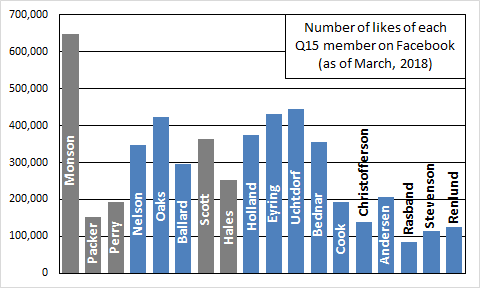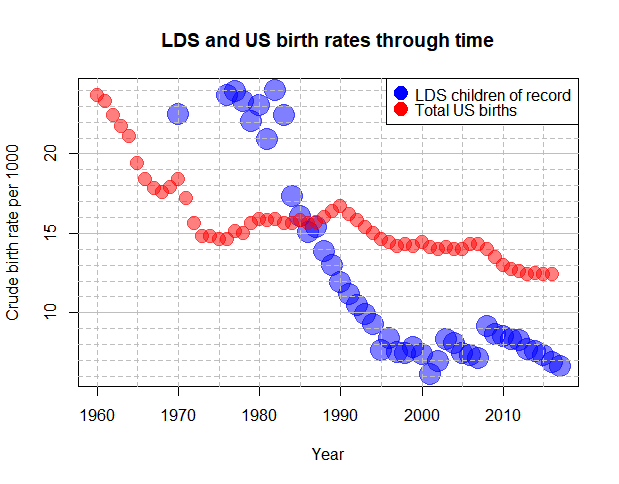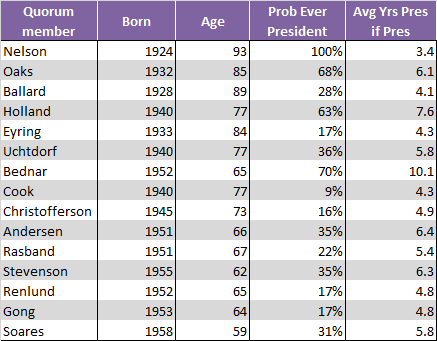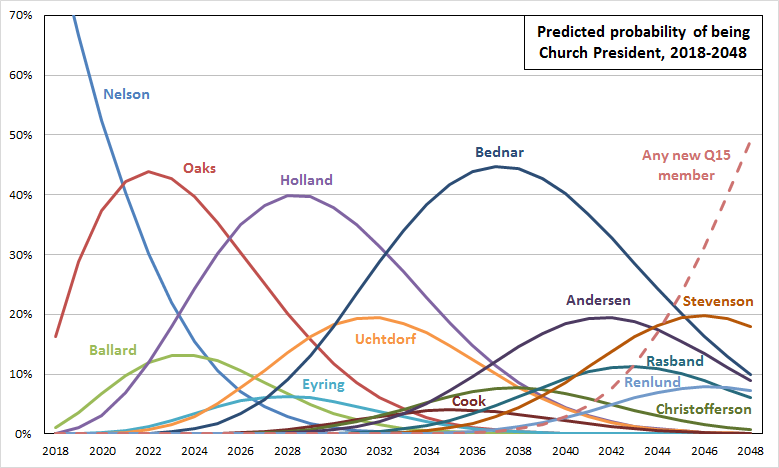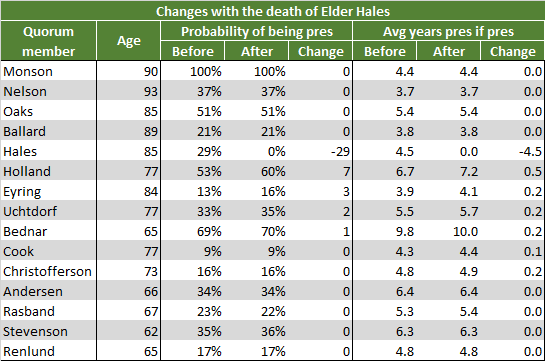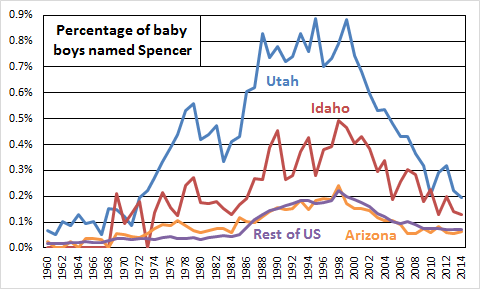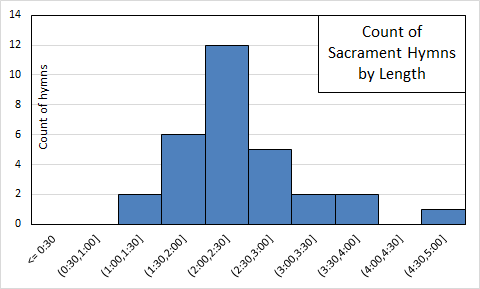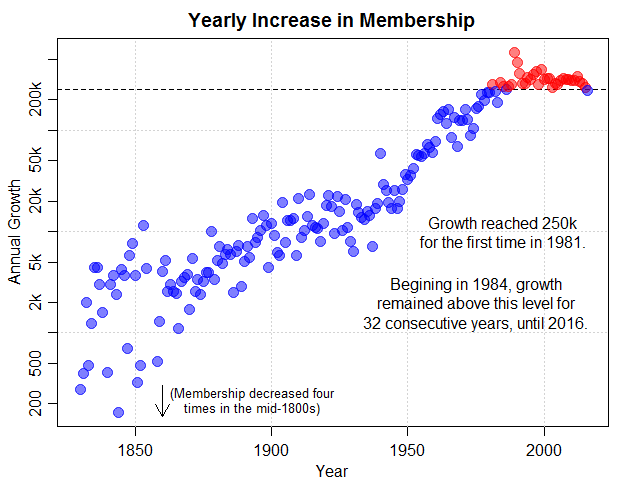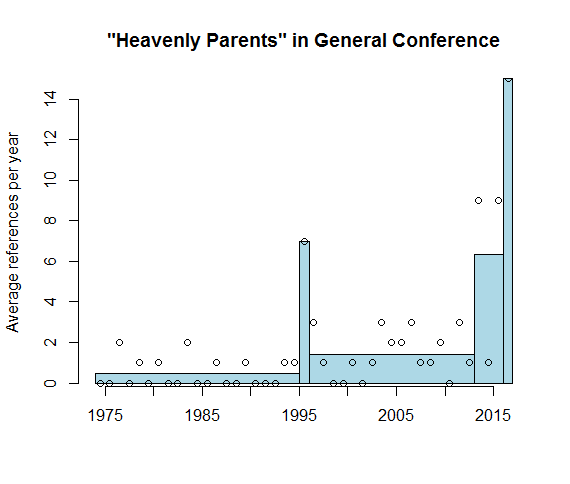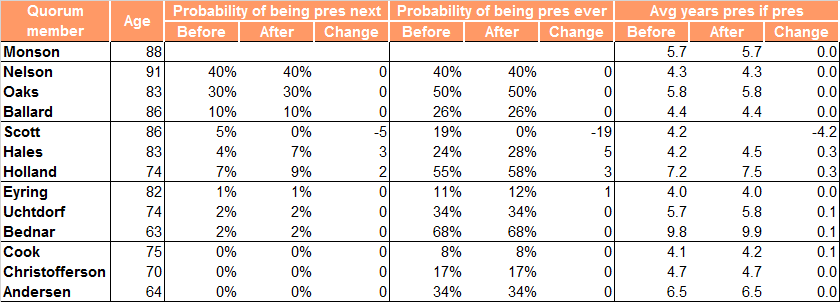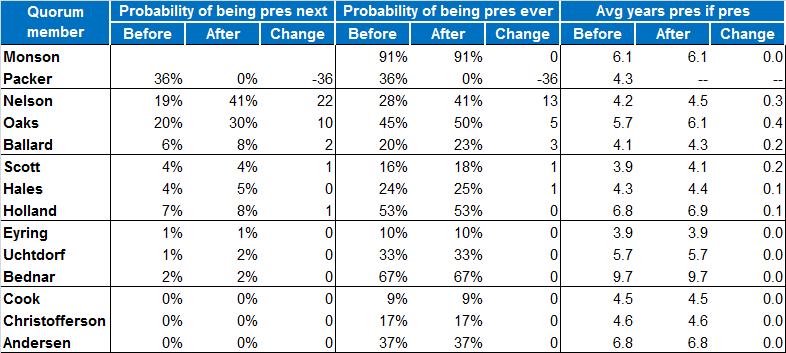Here’s a chart showing the total number of likes of Q15 members on Facebook as of late March of this year. Of course, the numbers have shifted a fair amount since then, especially for President Nelson, who’s gotten a big bump since becoming President.
Showing all posts in Statistics
Family size and church leadership
This guest post comes to us courtesy of Christian N. K. Anderson.
Recently, a friend told me her bishop came up to her, touched her belly, and asked, “Sister, when are you going to bring more spirit children into the world?” In a similar vein, an Elders Quorum President recently told a different friend in a different state that it was too bad she had only three children, as he had seven and they were all successful. The five married couples in my wife’s family have so far collectively produced one child, and we routinely swap stories of being criticized or asked openly by virtual strangers to justify this state of affairs. Why does this happen so frequently?
One of the ways Jello-Belt LDS culture is increasingly out-of-step with contemporary US culture is the belief that fecundity is positively correlated with virtue. Some of this no doubt stems from over-the-pulpit exhortations that “The commandment to multiply and replenish the earth has never been rescinded” (Packer, Apr 2015, compare first paragraph of the FamProc), the fetishizing of the family (as an institution, but with vigorous legal opposition to many instantiations of LDS families), and explicit direction to have children even when financially unable to do so (Andersen, Oct 2011; quoted and enhanced in the Eternal Family Sunday School manual). This empowers people like the bishop and EQP mentioned above to feel no qualms about intruding themselves into what would otherwise be a profoundly personal decision: they are simply encouraging fellow saints to become better humans by performing the Kantian categorical morally good act of having another child (no matter the circumstances) the same way they might encourage a fellow saint to forgive an enemy or visit a sick member.
These beliefs and rhetoric are increasingly anachronistic, not just in contemporary US culture, but among LDS members, and also among the LDS leaders who continue to make these sweeping generalizations. While a 2015 lesson manual encourage teachers to express disapproval for a US fertility rate that has dropped 45% since 1960, it fails to mention that rate at which LDS members reported their children fell by 70% over a far briefer period: from 24.2 children of record per 1000 members as recently as 1982 to 7.32 in the year of the manual’s publication. It has continued to decrease to 6.62 according to the most recent April 2018 statistical report. Of course, this is tracking children of record, not total number of births; with activity dropping below 33% in the US and 15% in Central America, a large number of babies born to nominal members are likely never recorded by ward clerks. Nevertheless, I expected this underreporting to be partially offset by church growth in countries with birth rates far higher than the United States’.
That’s *President* Soares to You: Probabilities of New Q12 Members Becoming Church President
I’m so happy that I was so wrong last week when I predicted that President Nelson would call two white men from Utah to fill the openings in the Quorum of the Twelve. I’m thrilled that Elders Gong and Soares can bring some new perspectives to the Q15. And of course, one of the first things I looked up when I learned that they had been called was how old they are, because I was curious about what the chances were that either of them would make it to be Church President.
In this post, I’ve updated the simulation that I’ve run before to estimate the probabilities of each Q15 member becoming Church President. I last did this just a few months ago when President Monson passed away. The gist of it is that I use a mortality table from the Society of Actuaries, assume that the yearly mortality probabilities apply to all members of the Q15 equally, and then run a bunch of simulations (100,000 in this case) and in each, pick a bunch of random numbers and compare them to the mortality probabilities for each member and use the comparison to work out how much longer each man would live, and the resulting way that the Presidency would be handed from one member to the next–which members would get to serve as President and which ones wouldn’t. The process is described in a little more detail in this post from 2015. Anyway, the numbers for the most senior 13 members have changed little since my post in January. What’s interesting here is the probabilities for the new Q15 members.
The table below shows the probability of each Q15 member becoming Church President, and how many years he would serve if he did. Note that if you compare carefully, you might notice some small discrepancies between this table and the one in my January post. When I was running the simulations for this post, I realized that when I ran simulations for my January post, I had calculated current age by rounding to the nearest birthday (e.g., a man who is 65 and 7 months is counted as being 66) rather than the more conventional approach of calculating it by just looking at last birthday passed. If you noticed this error in the previous post and didn’t feel the need to correct me, thank you!
Are Mormons More Homogeneous in Belief than Members of Other Churches?
Since she started attending church with the Episcopalians, I’ve heard my sister Lynnette observe that members of her new church appear to have a much broader range of beliefs than Mormons do. I guess I had never really thought about this, but if it’s true, this seems like maybe it shouldn’t be too surprising. There is lots of pressure to conform in Mormonism, all the way from scriptures that have Jesus saying “I say unto you, be one; and if ye are not one ye are not mine” to talks that exhort members to set aside the cultures they grew up in to join “the gospel culture.” And of course, this doesn’t even touch on the pressure at the local level to conform. Consider, for example, the immense backlash faced by women who participated in the “wear pants to church” actions a few years ago. They were not even going against a rule of any kind, but rather violating a norm and standing out, and this made a lot of rank-and-file members appear to lose their minds. I don’t have a very good sense of the Episcopal Church in general, but I’m guessing that, like many American Protestants, they are simply less top-down in their structure than Mormons are, so there’s more room for differences of opinion or even belief.
Really, though, what I thought would be even more interesting than reasoning out why or why not Mormons might be more homogeneous in belief than members of other churches, would be to see if there were any empirical evidence of this difference. It occurred to me that a great place to look would be the data gathered by the Pew Research Center in their Religious Landscape Study. It’s a US sample only, so it misses the larger fraction of Church membership that lives elsewhere, but it does represent the largest single concentration of Mormons in one country. I looked at Pew’s 2014 data. As these data are a few years old, they’ve already been discussed quite a bit on the Bloggernacle. I am coming at the results from a new angle, though. Rather than focusing on the particular answers respondents gave, I am interested in how similar the sets of answers are for members of the same church, regardless of what the particular answers are.
Yearly Church President Probabilities for Current Q15 Members
As a supplement to yesterday’s post, I’ve made the graph below that shows the year-to-year probabilities of each Q15 member being President.
The values come from the same mortality table that I used to run the simulation to find the likelihood of each Q15 member ever becoming Church President. This graph doesn’t require any simulation, though. For each Q15 member, I just used his yearly probabilities of survival to come up with yearly cumulative probabilities of survival (i.e., how likely is he to live through this age). Then for each Q15 member, his yearly probability of becoming President is the probability that he survives the year and that all the members senior to him do not. This is found by multiplying probabilities, so for example for Elder Ballard, who is junior only to President Nelson and Elder Oaks, his probability of being President in a particular year is this:
(Ballard cumulative probability of living)*(1 – Nelson probability of living)*(1 – Oaks probability of living)
The results look similar to what we’ve seen in the past with graphs like this, in that there are big probabilities across periods of years for Elders Oaks, Holland, and Bednar. The one big difference is that, as el oso noted yesterday, President Nelson jumped from a pretty low probability for most of his time in the quorum to 100% when President Monson died. I guess this just illustrates that applying a mortality table that gives general trends to a small group of people as I have here is bound to be wrong in big ways at times.
Church President Probability Changes with President Monson’s Death
As you are no doubt aware, President Monson passed away Tuesday evening. As I have before when a member of the Q15 passes away, in this post I’ll show how the probabilities of becoming Church President change for the other members as a result.
All the probabilities come from a simulation I did for a post back in 2015. It’s a straightforward simulation: it uses an actuarial table and each Q15 member’s age and seniority in the quorum as inputs, and it draws a series of random numbers to simulate different possible life expectancies for each member. The life expectancies are then compared to find in what fraction of the simulations each member outlives all other members senior to him to become President. I did 100,000 replications for each run. That is, 100,000 times I drew random numbers for each Q15 member and compared them to his survival probability each year, and then worked out whether each member would become President or not in that scenario, and how many years he would serve if he did. For a more detailed description of the process, see my earlier post.
I realized when writing this post up that I had never done a post to show changes in the probabilities after Elder Hales passed away last October. I’ll start with that. This table shows the changes in probabilities and average number of years serving as President for the other Q15 members after Elder Hales died. Note that all the numbers, including ages, are as of October, 2017.
What fraction of missionaries are sisters?
It has been five years since President Monson announced the change in minimum ages at which missionaries can serve. It’s clear that much of the increase in the number of missionaries that followed that announcement came from an increase in how many women were choosing to serve. For example, a 2015 ABC News article on sister missionaries reports (I assume quoting a Church spokesperson) that there were 22,000 sister missionaries at the time, that they made up more than a quarter of all missionaries, and that their numbers had nearly tripled since the age change was announced. Along similar lines, a Deseret News article from one year after the age change reports that there had been increases of 10,000 elders and 11,000 sisters in the previous year. There’s also a Deseret News article from 2014 that gives actual percentage breakdowns: 64% single men, 28% single women, and 8% senior couples.
This increase matches my anecdotal experience. I haven’t tracked anything systematically, but just from following friends on Facebook, it seems like a lot more families who I would have thought were pretty conventionally Mormon have sent daughters on missions in the past few years than did before. I note that they’re conventional because my impression is that having women serve missions before the age change always seemed to me to be a little out of the norm. Like the thinking was that it was a nice thing to do and all, but really shouldn’t women be getting married instead?
It’s great that the news articles I mentioned give some point-in-time snapshots of how many women are serving missions, but what I’m really interested to know is what the trend over time is. For example, I wonder if the number of women serving increased suddenly right after the age change, but then leveled off. Or perhaps it increased at that time, and has continued to increase since then. Or maybe there was a temporary spike and then the number of women serving have decreased.
Like with so many other questions about Church-related data, I’m sure the numbers are available somewhere in the COB, but I’m never going to get to see them. So I did the next best thing and gathered a little data from what I could find. I considered possibilities like counting women and men in missionary alumni Facebook groups, or on a website like LDSMissions.com that allows returned missionaries to register and join a group of others who served in the same mission (although it doesn’t look like the site has been updated in a while). I ended up, though, choosing to gather data from MyMission.com, though, for a couple of reasons. First, it has lists of links to missionary blogs in a nice standard format that was relatively easy to grab. Second, it has missionaries listed as “Sister” or “Elder,” so I didn’t have to make any assumptions about whether someone with a particular first name was female or male.
Book of Mormon people’s names my parents give to me!
In my last post, I looked at how often children in Utah, Idaho, and Arizona are named after the current Church President. I thought it also might be interesting to look at how often children are named after people in the Book of Mormon. One advantage of looking at Book of Mormon names is that it doesn’t require me to limit myself to states with lots of Mormons. If you’re naming your child Nephi, you’re probably Mormon, regardless of where you live. The downside, of course, is that this rules out names that are not unique to the Book of Mormon. For example, someone naming their child Benjamin may be thinking of the Book of Mormon king, but there are many other Benjamins out there that their choice was more likely inspired by.
Because using a Book of Mormon name is a clear marker of Mormonness, there’s even good reason to have a hypothesis beforehand about what the data will look like. In The Angel and the Beehive, Armand Mauss talks about the Church’s shift between the 1960s and 1990s from leaning toward assimilation with the broader world, toward more retrenchment. I think it would make sense to expect that Mormons would use more distinctly Mormon names during a period of retrenchment, when drawing bright lines between the Church and the world is an important practice, than during a period of assimilation. Therefore, I expected to see increasing usage of Book of Mormon names between the 1960s and 1990s.
I got data from the same sources as I did for my last post: the Social Security Administration (SSA) name database for counts of how often names are used by state and year from 1960 to 2014, and CDC Vital Statistics reports for counts of total births by state and year for the same time period. Here is an alphabetical list of the Book of Mormon names I checked:
Abinadi, Abish, Helaman, Jarom, Lehi, Limhi, Mahonri, Mormon, Moroni, Mosiah, Nephi, Omni, Sariah, Teancum, Zeniff
I looked at the girls’ names first: Abish and Sariah. Unfortunately, Abish only shows up in three of the years (1999, 2000, and 2003). The SSA database doesn’t report counts of less than five (for either a state or the entire country), so it’s likely that the name was used in other years, but just fewer than five times. For Sariah, I ran into a different problem. I thought it was a uniquely Book of Mormon name, but while the SSA data shows elevated levels of usage in Utah, Idaho, and Arizona, the name also appears in lots of other states. Overall, Utah, Idaho, and Arizona account for only 11% of uses of the name. I wonder if it isn’t being used by people not referring to the Book of Mormon as an alternative spelling of Saria or another takeoff on Sara(h). In any case, given that the name doesn’t appear to be an indicator of Mormonness, I put it in the non-unique bin with names like Benjamin.
For three of the boys’ names, I found no hits at all: Limhi, Mormon, and Zeniff. Because of the reporting threshold of five, this doesn’t mean these names are never used, but if they are, it’s clearly very rare.
The remainder of my analysis looks at just the remaining ten names. Here’s a graph showing how often they are used in the full US data.
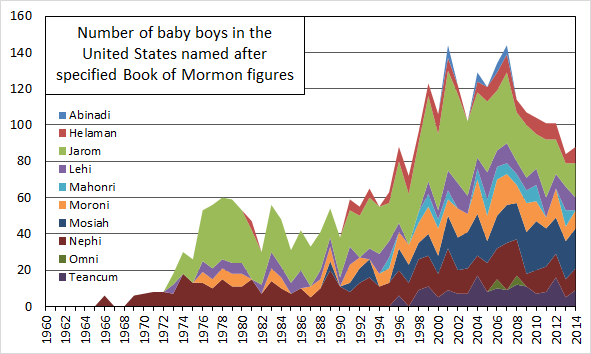 To me, the big surprise here is Jarom. I would never have guessed that it would be used most among the list of names I started with. I included it kind of as an afterthought, since he’s such a minor character.
To me, the big surprise here is Jarom. I would never have guessed that it would be used most among the list of names I started with. I included it kind of as an afterthought, since he’s such a minor character.
Follow the Prophet(‘s Name)
Do Mormons name our kids after the current Church President? I’ve known some people who have (or at least I’m assuming that was their inspiration–Hinckley seems like an unusual name to use for any other reason), but I wondered if it was a more general phenomenon.
Unfortunately, I don’t have Mormon-specific naming data, nor do I have data from outside the US. What I do have is the Social Security name database, which gives yearly counts of names used by state. So I thought it might be interesting to at least look at whether states with lots of Mormons use names of Church Presidents more often than other US states, especially starting around the time a Church President is called. I assembled the name data and the yearly birth count data from the CDC’s Vital Statistics reports as described in this post from last year. As in that post, I got data for the years 1960 through 2014.
I checked the first and last names of all Church Presidents since David O. McKay, although as he became Church President in 1951, I couldn’t check whether there was a change at that time. I compared the percentage of babies given those names in Utah, Idaho, and Arizona, and also the percentage in the rest of the US. The Social Security data reports counts separately for girls and boys, so I checked each name for both. For nearly all the Presidents’ names, I couldn’t see any evidence of the pattern I was looking for. Either the states with lots of Mormons used the name less than the rest of the country, or they hardly used the name at all, or there was no change around the time the President having the name was called.
There are three exceptions, where there is at least a hint that something is going on. All (not surprisingly) are for boys. The names are Spencer (W. Kimball), (Howard W.) Hunter, and Thomas (S. Monson). Here is the graph for Spencer.
Sacrament Hymns, Ranked (by length)
I have a priest-aged son, and seeing him administer the sacrament has made me pay more attention to the process than I had since I was a priest myself. One issue that I noticed last week was that the sacrament hymn seemed really short, and my son and the other priest hadn’t finished breaking the bread by the time it was over. Of course this isn’t all that unusual. The organist just played through the hymn again while they finished. It was only a matter of a few seconds, but it brought to mind that when I was a priest, I always worried about this happening, because I could feel the pressure of everyone in the congregation waiting for me to just hurry up and finish.
This got me to wondering, though, about how long the sacrament hymns actually are. I looked up the 30 hymns listed under the topic “sacrament” in the back of the hymnbook. (They are all grouped together between hymn numbers 169 and 197, except for #146, “Gently Raise the Sacred Strain.”) I calculated the length of each hymn given its time signature, number of measures and verses, and suggested tempo (I used the midpoint of the lengths implied by taking the fastest and slowest of the suggested tempos.) I included only the verses actually printed in the music because, at least in my experience, it’s typically only those verses that are sung. I didn’t make any adjustment for fermatas.
Here’s the result. It looks like most sacrament hymns are between 1:30 and 3:00 long. A few are shorter. A few are quite a bit longer.
Well, speak of the devil!
In Lynnette’s post a couple of days ago on turning to Christ in the midst of sin, she wrote about how she identified with the struggle to feel worthy to turn to Christ that Martin Luther expressed hundreds of years ago, although, she noted, Luther was more likely to attribute the difficulty of the struggle to the whisperings of Satan, while she as a product of the twentieth century leans more on the language of mental illness. This is a major tangent, but this contrast got me to wondering which GAs today are more or less likely to attribute things to Satan.
Figuring out who’s attributing stuff to Satan is a more difficult task than I really wanted to take on, so I settled for just looking up which GAs talk about Satan the most. Fortunately for me, the LDS General Conference corpus has recently been updated to make it much easier to get results split out by speaker. This even allowed me to broaden my search a little, to include other Conference speakers such as general church officers. I searched the corpus by speaker for uses of “Satan,” as well as three fairly synonymous terms: “devil,” “Lucifer,” and “adversary.” Then I just added up the frequency for each speaker, and converted the results into uses per million words to make them easier to look at. (If you’re interested in differences between how often these terms are used here’s a post I wrote several years ago on that question.)
So who do you think holds the title for referring to Satan most frequently in Conference talks?
You’ll never guess.
Really, you won’t.
The Slowing of Church Growth
This post comes to us from Christian Anderson, a biostatistician living in San Diego county. He previously guest posted on mentions of Heavenly Parents in General Conference.
In the Saturday Afternoon Session of General Conference on Apr 1, 2017, the church announced a membership of 15,882,417. Combined with last year’s total, this represented an increase of 248,218 members and 1.59%. For many denominations, this would be a banner year. However, for the LDS church it represents a remarkable underperformance relative to historical trends and enthusiastic predictions by some members.
Absolute growth
In terms of absolute growth, the addition of nearly a quarter million members is still a substantial achievement. After all, the church didn’t reach 250,000 members total until 1897. However, since 1984 the church had reported growth of at least that magnitude for 32 consecutive years until last Saturday. Reported is an important word here, as membership totals reported in General Conference were rounded off to the nearest 10,000 from 1984-1991, and there are several statistical anomalies in the various time series suggesting that totals sometimes reflect incomplete reports (usually reflected by an anomaly in the opposite direction in the next year).
Estimating New Q15 Member Calls by Future Church Presidents
A lot of discussion around US Presidential elections concerns what types of justices a candidate might appoint to the Supreme Court. This is of course particularly an issue when, as is the case now, some of the justices are quite old. It occurred to me that although it’s not exactly the same thing, a related Mormon question is how many new Q15 members future Church Presidents are expected to call.
Heavenly Parents at Conference
This guest post comes to us from Christian Anderson.
It’s always nice to hear how the old folks at home are doing. It seems like we’ve been hearing more and more about Them recently.
Back in April 2013, Ziff (https://zelophehadsdaughters.com/2013/04/29/heavenly-parents-are-we-really-talking-about-you-more/ and references therein) noted that there seemed to be an increasing number of references to “Heavenly Parents” in General Conference and more widely in church materials. This post discusses three aspects of that trend: 1) It has not only continued but accelerated over the last three years, 2) there has been a shift in which authorities are mentioning Them, and 3) the fraught issue of capitalization.
An accelerating trend
Few speakers mentioned Heavenly Parents in the decades before 1995, with an average of 0.48 references per year (that’s both April and October conferences combined). That all changed with “The Family: A Proclamation to the World”, which affirms in its third sentence that each human being is “a beloved spirit son or daughter of heavenly parents”, triggering seven references to Heavenly Parents that year. In the years 1996-2012, references to “Heavenly Parents” nearly tripled to 1.41 references per year (p=0.0057), but never more than three in any one year. 2013 saw a spike to a record nine references, followed by a fall back to one reference in 2014, a return to nine references in 2015, and finally a grand total of 15 references this year. Exactly half of the 56 talks that mention Heavenly Parents have been delivered in the last four years.
Do Utah and Idaho use more unusual names than other states do? Part I
I enjoyed Jessie Jensen’s post a couple of months ago at BCC where she reported on a number of unusual names used for babies born in Rexburg and Idaho Falls in 2015. One question that came up in the comments was whether Mormons (or at least Mormons in Utah or Idaho) actually use more unusual names than people in other places do. I was interested in this question, and my co-blogger Katya pointed out that the US Social Security Administration (SSA) actually publishes data on how often different names are used in each state each year. So I thought it might be fun to look at these data, and see if they could help me attempt to answer the question.
No, there have not been 30 talks about child abuse in General Conference since 1976
The Mormon Newsroom article on child abuse from 2010 that was recently published with a 2016 date (because of a “technical error”) includes the following claim, as evidence of how seriously the Church takes child abuse:
Since 1976, more than 50 articles have appeared in Church publications condemning child abuse or educating members about it. As wrenching as the topic is, Church leaders have given sermons about it more than 30 times at the Church’s worldwide conferences.
I spend a fair amount of time poking through old General Conference talks, and this latter number—30 sermons about child abuse—seemed high to me. So I thought I would check it.
I used the lds.org search tool to search for “child abuse” (without the quotation marks), and limited the results to General Conference talks. The search doesn’t require the words to appear together, so I was casting a pretty wide net, not just looking for talks that had the exact phrase “child abuse.” In fact, I ended up having to discard a bunch of talks in the results because they never discussed child abuse even though they included both words (frequently they talked about drug abuse and mentioned a child in another context).
Your Favorite ZD Posts
We launched Zelophehad’s Daughters in January of 2006, so it’s ten years old this month. A decade! There are a lot of older blogs on the Bloggernacle, but I’m still kind of amazed by this. I don’t think I would have guessed when we started that we would continue for this long.
To celebrate our tenth birthday, I looked back at our posts that generated the most traffic. Here is a list of the highest-traffic1 post by each person who has blogged here regularly.
Apame: It wasn’t about pants…but then it became about pants. And that’s why I’m wearing pants.
Beatrice: Another Conversation Stopper
The Bouncer: LDS Church Leadership Agrees to Meet with Kate Kelly
Elbereth: The Five Universal Truths of Road Trips
Eve: Don’t Be My Ally*
Galdralag: For Kate
Katya: How EFY Promotes Immodesty
Kiskilili: If A Woman Strips Naked in a Forest and No One Sees Her, Is She Still Pornography?
Lynnette: Church Discourse on Homosexuality
Melyngoch: Seven Modest Outfits from the Golden Globes
Mike C: The More Things Change…
Pandora: Dona Nobis Aequalitatem
Petra: I Loved to See the Temple
Seraphine: Being a 30-something Single in the Church: Part V, the Law of Chastity
Vada: I Hate Breastfeeding
Ziff: Church President Probability Changes with President Packer’s Death
Of course traffic is far from a perfect measure of what posts are most enjoyed. If you like, please feel free to share your favorite ZD posts in the comments.
__________
1. I took data from our StatCounter plugin and subtracted out the traffic numbers for days close in time that had zero posts, so that kind of adjusts for the general traffic level at the time. We just have a free StatCounter account, so I didn’t have traffic by post page, so I just used total traffic on the day a post was written and also attributed to it some fraction of traffic for the next few days, but less if there was also a new post up in the next few days. Really, this is just for fun, so you probably don’t much care too much about my method. 🙂
Predicting Who Will Be Church President (Updated with new Q15 members!)
Knowing that three new members of the Q15 were going to be called at the same time this Conference, I was interested not only in who would be called, but also in how old the new members would be. The Quorum is old: its youngest member going into Conference was Elder Bednar at 63. If a whippersnapper the age of Elder Bednar at the time of his calling (52) or Elder Oaks at the time of his (51) had been called, such a person would have entered the Quorum with a very high probability from day one of eventually becoming Church President.
But, as we’ve seen, no whippersnappers were called. Elder Rasband is 64; Elder Stevenson is 60; Elder Renlund is 62. Elder Bednar did finally lose his position as youngest man in the Q15 to Elder Stevenson, though. He had held this title since he was called over a decade ago.
Here’s an updated look at probabilities of becoming Church President for each Q15 member.
Church President Probability Changes with Elder Scott’s Death
Elder Richard G. Scott died yesterday at the age of 86. As I did when Elder Perry and President Packer died, in this post, I’ll show how this changes the probabilities of becoming Church President for the remainder of the members of the Q15.
All the probabilities come from a simulation I did for a post back in April. It’s a straightforward simulation: it uses an actuarial table and each Q15 member’s age and seniority in the quorum as inputs, and it draws a series of random numbers to simulate different possible life expectancies for each member. The life expectancies are then compared to find in what fraction of the simulations each member outlives all other members senior to him to become President. For a more detailed description, see my April post.
Here are the changes with Elder Scott’s death:
Church President Probability Changes with President Packer’s Death
President Boyd K. Packer died on Friday at the age of 90. As I did when Elder Perry died, I thought it would be interesting to look at how this changes the probabilities of becoming Church President for the other members of the Q15
Here are their probabilities and average predicted years of being President before and after President Packer’s death. These come from the simulation I posted about a few months ago where I used a mortality table to run 1000 scenarios and see in how many each Q15 member would become Church President.
